About the OU School of Music
The School of Music at the University of Oklahoma maintains its proud traditions while offering visionary programs that prepare students for an evolving and exciting future. The University of Oklahoma has been an institutional member of the National Association of Schools of Music since 1931. The OU School of Music is the only comprehensive music program in Oklahoma. We offer degrees at the Bachelor’s, Master’s and Doctoral levels in all areas of music performance, composition, education, history and theory. With 60+ full-time faculty members and 450 music majors, the School of Music presents over 400 performance and scholarly events each year. Our world-class music faculty is augmented by an outstanding music facility that includes four state-of-the-art performance halls and a comprehensive Fine Arts Library. School of Music graduates occupy prestigious academic and performance positions worldwide. Please explore this website in depth to learn more about the OU School of Music, and I invite you to visit our campus to witness how music is a part of the exciting campus life.
Mission Statement
The Mission of the School of Music at The University of Oklahoma is to advance learning, teaching, scholarly and creative activity, and service. Faculty and students will actively promote and contribute to the teaching profession, discover knowledge as performers and researchers, and enhance the discipline of music through professional service at the national and international levels. Established in 1903, the School of Music was the second School formed on the OU campus and has been an Institutional Member of the National Association of Schools of Music since 1931. As the only doctoral-granting music school in Oklahoma, the OU School of Music will serve its constituents through the artistic and scholarly productivity of its faculty, students, and alumni. The University of Oklahoma awards music degrees in the areas of composition, education, musicology, pedagogy, performance, and theory. The School of Music at OU maintains its traditions while offering programs that prepare students for an evolving and exciting future.
Goals
The goals of the OU School of Music are to be the school of choice for highly qualified students across the nation, to create access and opportunity for students who demonstrate promise and potential, and to be among the top public university schools of music in the United States. Graduates of the School of Music will compete among the nation’s best musicians, scholars, and teachers in all professional endeavors.
Diversity, Equity, Inclusion, and Belonging in the School of Music
The University of Oklahoma School of Music is deeply committed to creating and maintaining an equitable, diverse, and inclusive environment by recognizing that all individuals bring their own unique backgrounds, beliefs, and perspectives to our campus. Our academic and artistic work is made stronger by the diversity of our community and by our differences in race, ethnicity, culture, experience, national origin, religious beliefs, sexual orientation, gender, gender identity, gender expression, age, political viewpoints, and more. The School of Music will continue to strive to nurture a profound sense of belonging and support for all students, staff, and faculty as we recognize that fostering an inclusive environment for all is at the very heart of our pursuit of academic and musical excellence.
Musical Opportunities
The musical life in Norman and on the OU campus is among the most exciting in the State and Midwest. In a typical academic year, the School of Music sponsors over 250 concerts and recitals. These performances include both faculty and student chamber recitals and concerts by bands, choruses, and orchestras sponsored by the School. Students may acquire complimentary tickets for all School of Music events, pending availability.
Weitzenhoffer Family College of Fine Arts - Mission Statement
The Weitzenhoffer Family College of Fine Arts, an integral part of the University of Oklahoma, recognizes the universal language of the arts and its crucial role in creating and sustaining a vibrant environment. The College is committed to a standard of excellence in the fine arts encompassing the University’s mandate for teaching, research/creative activity, and service. The faculty, staff and students are dedicated to the promotion of the arts within the state of Oklahoma, the nation, and the international community.
Facilities
The 25 million dollar Catlett Music Center is home to the University of Oklahoma's School of Music, Symphony Orchestra, the Pride of Oklahoma marching band and numerous faculty and student ensembles. World-class concerts and events are held regularly in Catlett Music Center which was completed in 1998.
Catlett contains the School of Music's administrative and faculty offices, along with studios, rehearsal suites, classrooms, MIDI labs, the Grant Fine Arts Library, a recording studio, and three performance halls. The performance halls are the Paul F. Sharp Concert Hall, Morris R. Pitman Recital Hall, and Grayce B. Kerr Gothic Hall. The School of Music is a fully accredited institutional member of the National Association of Schools of Music. The requirements for admission and graduation are in accordance with the published regulations of the N.A.S.M.
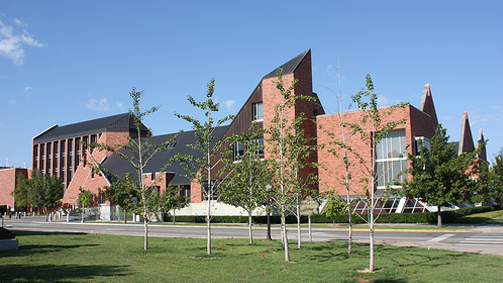 Designed by Kaighn Associates Architects, the building's distinctive "Cherokee Gothic" style captures the angular parapet wall construction found in other early campus buildings. The unique projected window elements also capture the similar projected window style found in earlier buildings located on the University of Oklahoma campus. The use of copper roofing matches other copper roofs found on campus and play out their own sense of harmony. The copper roof lines visually change with time actually deepening in color with age.
Designed by Kaighn Associates Architects, the building's distinctive "Cherokee Gothic" style captures the angular parapet wall construction found in other early campus buildings. The unique projected window elements also capture the similar projected window style found in earlier buildings located on the University of Oklahoma campus. The use of copper roofing matches other copper roofs found on campus and play out their own sense of harmony. The copper roof lines visually change with time actually deepening in color with age.
The interesting shapes and articulation found throughout the building are intended to spark the creative imagination much as music does for the human spirit. The architectural rhythms and angular counterpoints likewise play through the mind intended to create visual interest and impact. The Catlett Music Building is memorable, functions well, and has grown to be loved by performers, faculty, students, and patrons.
The Catlett Music Center provides expansive rehearsal suites for large performing ensembles. Rehearsal suites for orchestra, band, and choral areas are acoustically designed for the enhancement of the teaching and learning processes. Each suite contains equipment for the recording and playback of rehearsals to aid in the learning process as well as large libraries of repertoire which are continuously updated. The percussion suite is an extensive complex of large rehearsal rooms, offices, and five practice rooms dedicated for percussion studies. The University of Oklahoma Percussion Press, which publishes literature for all levels of percussion study from solos to large percussion ensembles, is also located in the percussion suite.
Two electronic piano labs facilitate the teaching of piano skills to beginning pianists. In conjunction with these labs, the piano pedagogy program maintains the Ruby Grant Piano Pedagogy Resource Center, a repository for information and literature invaluable to students and educators alike. The choral rehearsal room in Catlett Music Center can be "tuned" by panels on the walls that open out or remain flush to absorb or reflect sound, depending on the size and type of ensemble performing. The University of Oklahoma Fine Arts branch library houses the collection of materials supportive to the disciplines of art, dance and music. Located in the Stanley B. Catlett Music Center, the Fine Arts Library holds 81,000 volumes of books, 2,087 reels of microfilm, and 8,440 sheets of microfiche.
 The Grayce B. Kerr Gothic Hall houses the Mildred Andrews Boggess Memorial Organ, a $750,000 instrument designed specifically for the School of Music by the C. B. Fisk Company. Kerr Gothic Hall serves as a grand entrance to the School of Music and a lobby for the performance spaces in the Catlett Music Center. The large interior entry space identified as Gothic Hall is architecturally unique due to its high volume of space, play of light through the large east exterior windows, and use of structural elements to capture the essence of the "Old Gothic Hall Cathedrals." During the day, sunlight filters through the large stained glass windows into the hall and at night the interior lighting filters out through the windows dramatically lighting the east face like a jewel. The upper north end of the space houses a fully functional organ assembly so that vocal and music performance can be accomplished within the space.
The Grayce B. Kerr Gothic Hall houses the Mildred Andrews Boggess Memorial Organ, a $750,000 instrument designed specifically for the School of Music by the C. B. Fisk Company. Kerr Gothic Hall serves as a grand entrance to the School of Music and a lobby for the performance spaces in the Catlett Music Center. The large interior entry space identified as Gothic Hall is architecturally unique due to its high volume of space, play of light through the large east exterior windows, and use of structural elements to capture the essence of the "Old Gothic Hall Cathedrals." During the day, sunlight filters through the large stained glass windows into the hall and at night the interior lighting filters out through the windows dramatically lighting the east face like a jewel. The upper north end of the space houses a fully functional organ assembly so that vocal and music performance can be accomplished within the space.
The Paul F. Sharp Concert Hall provides seating for 1,018 patrons to enjoy the remarkable acoustics and architectural beauty of this Prairie Gothic style performance space. The smaller Morris R. Pitman Recital Hall reflects many of the same architectural details of the Paul F. Sharp Concert Hall and creates an intimate environment for 125 patrons to enjoy faculty and student chamber music recitals and lectures.
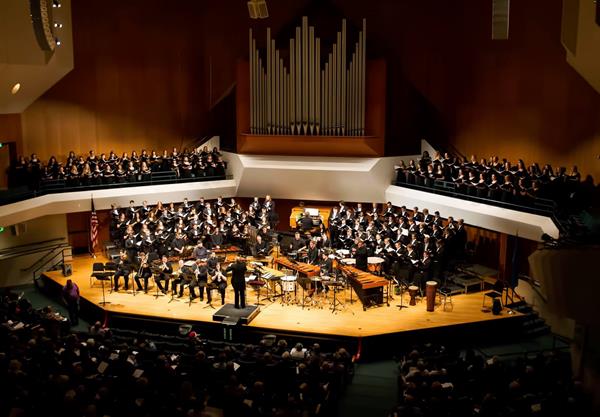 The Paul F. Sharp Concert Hall provides seating for 1,018 patrons to enjoy the remarkable acoustics and architectural beauty of this Prairie Gothic style performance space. The space is acoustically designed to be a pure concert hall, rather than an auditorium, with a gridded ceiling that allows music to rise and fill the space without overwhelming patrons. The Paul F. Sharp Concert Hall is the largest formal assembly area on campus. Response to the sounds of the hall have been overwhelmingly positive, as is student reaction to the state-of-the-art equipment that records their performances. A sound room overlooks the hall to allow in-house recordings of all events; technicians can record CDs directly during a concert and give students copies of their recitals 10 minutes after the last note is heard.
The Paul F. Sharp Concert Hall provides seating for 1,018 patrons to enjoy the remarkable acoustics and architectural beauty of this Prairie Gothic style performance space. The space is acoustically designed to be a pure concert hall, rather than an auditorium, with a gridded ceiling that allows music to rise and fill the space without overwhelming patrons. The Paul F. Sharp Concert Hall is the largest formal assembly area on campus. Response to the sounds of the hall have been overwhelmingly positive, as is student reaction to the state-of-the-art equipment that records their performances. A sound room overlooks the hall to allow in-house recordings of all events; technicians can record CDs directly during a concert and give students copies of their recitals 10 minutes after the last note is heard.
Walking through the majestic Grayce B. Kerr Gothic Hall, one of a triad of performance facilities that comprise the Catlett Music Center, evokes the resonance and drama of a Renaissance cathedral. Footsteps echo off the hard brick walls and floating concrete floors, reverberating an astounding 4.5 seconds as the sound soars to the 75-foot vaulted ceiling and streams down, engulfing the pedestrian. Crossing the threshold into the vestibule of the Paul F. Sharp Concert Hall plunges the concertgoer into a chamber of virtual sensory deprivation, where noise is muffled, almost ceasing to exist. Entrance into the hall proper brings the sound back up, preparing the listener for an emotional response to the music being played.
The vestibule area of the Paul F Sharp Concert Hall grants multiple pathways for patrons to choose their seats. Sound absorbing wall treatments insure the subtle illusion that one is entering a library and create a sound barrier between the hall proper and the bustling activity outside the hall. Featured in the vestibule is a bust of Dr. Sharp along with areas to display information related to a performance. Outside the hall are restroom facilities, a well-equipped concession area, and the School of Music's Ticket Office.
The elevated, octagonal, hardwood floored performance stage in Sharp measures 60' wide by 40' deep. A state of the art lighting system provides uniform colored lighting while insuring that the lighting fixtures are not obtrusive to the performer's eyes. Even though one might hear a pin drop on the stage from any seat in the house, a state of the art audio system is provided. The recording studio quality audio system allows every nuance of a performance to be accurately captured on digital media. Complete video capability is available including the capability to stream live performances to the internet. Flanking the performance area on three sides is the Choir balcony. The right and left balconies offer two standing levels and are 10' deep by 30' long. The center balcony offers another 30' wide by 10' deep area on a single level.
The ceiling treatment within Sharp Concert Hall is designed to admit sound into a 15' high equipment area above the seats where it can be attenuated. The area directly over the performance stage is filled in to reflect sound into the room while the area over and around the 1,018 seats is designed to enhance reverberation without creating annoying echoes and distortions. Above the ceiling are the room's HVAC ducting which has been designed for "library quiet" operation. As one walks around the orchestra floor and balcony seating areas the sound heard from the performance area is uniform in volume and contains all the acoustic clarity and nuance the performance is imparting. In Sharp Hall it doesn't matter if it is a solo piano performance or the entire Sooner Orchestra and Choir performing together, the room acoustics don't overwhelm the listener relaxing in the comfortable seating.
The balcony seating is extended along the side walls of the 85' wide hall as shown in the image above. The wall surfaces of the concert hall are set at irregular angles to control sound reflections within the room. As the main orchestra floor seating rises up towards the back of the hall, the staggered seating affords every patron both an unobstructed view of the performance area as well as "the perfect seat" from which to enjoy an orchestral concert or choir offering.
Standing on the performance stage one quickly notices the use of thick plate glass panels across the rear of the orchestral seating area and along the side walls to provide acoustic separation of the seating areas from the vestibule and pedestrian hallway areas. The glass imparts a spaciousness to the design while providing the necessary hard reflective surfaces necessary to maintain a flat acoustic room signature. The comfortable green upholstered seats provide cozy intimate seating comparable to one's favorite home chair.
To accommodate those with mobility concerns, the hallways within Sharp are ramped and include handrails. Wall surfaces are treated with acoustically absorbent materials to limit sound transmission into the seating areas. Parking is never a problem as the University operates the Elm Avenue Parking Facility which is a five level parking garage offering 576 parking spaces including sixteen disability spaces for those with OU permits. A short walk from Catlett is the 171 space Oklahoma Memorial Union Parking Garage.
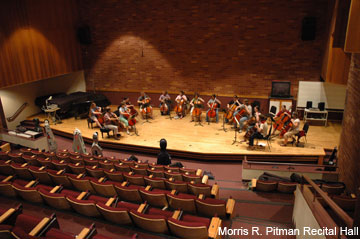 The School of Music is housed in the Catlett Music Center on the north end of the campus, the entrance to which is a striking contemporary space of cathedral proportions. The Morris R. Pitman Recital Hall and the Paul F. Sharp Concert Hall both open off this grand space as does a corridor leading to the classrooms and teaching studios.
The School of Music is housed in the Catlett Music Center on the north end of the campus, the entrance to which is a striking contemporary space of cathedral proportions. The Morris R. Pitman Recital Hall and the Paul F. Sharp Concert Hall both open off this grand space as does a corridor leading to the classrooms and teaching studios.
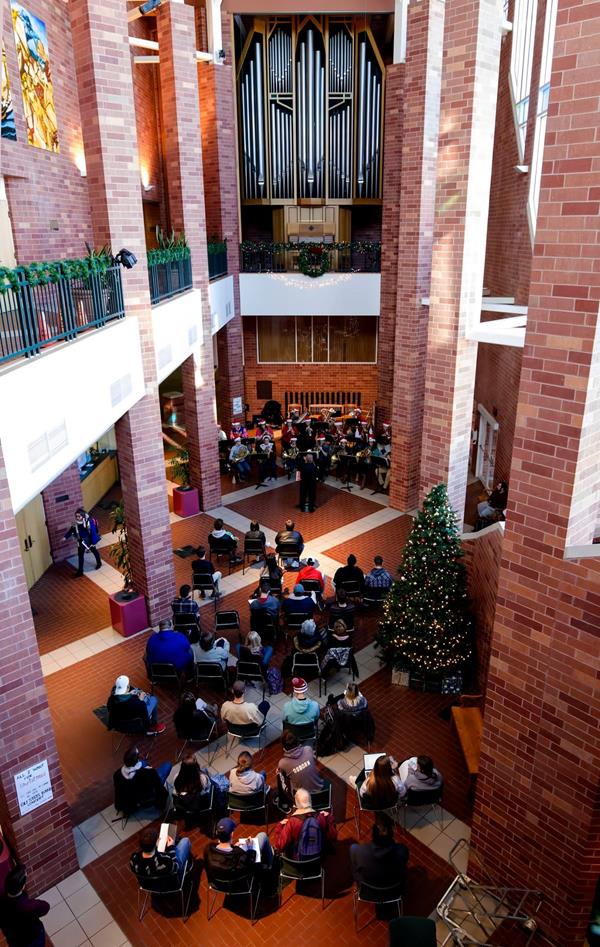 The Grayce B. Kerr Gothic Hall houses the Mildred Andrews Boggess Memorial Organ, a $750,000 instrument designed specifically for the School of Music by the C. B. Fisk Company. Kerr Gothic Hall serves as a grand entrance to the School of Music and a lobby for the performance spaces in the Catlett Music Center. The large interior entry space identified as Gothic Hall is architecturally unique due to its high volume of space, play of light through the large east exterior windows, and use of structural elements to capture the essence of the “Old Gothic Hall Cathedrals”. During the day, sunlight filters through the large stained glass windows into the hall and at night the interior lighting filters out through the windows dramatically lighting the east face like a jewel. The upper north end of the space houses a fully functional organ assembly so that vocal and music performance can be accomplished within the space.
The Grayce B. Kerr Gothic Hall houses the Mildred Andrews Boggess Memorial Organ, a $750,000 instrument designed specifically for the School of Music by the C. B. Fisk Company. Kerr Gothic Hall serves as a grand entrance to the School of Music and a lobby for the performance spaces in the Catlett Music Center. The large interior entry space identified as Gothic Hall is architecturally unique due to its high volume of space, play of light through the large east exterior windows, and use of structural elements to capture the essence of the “Old Gothic Hall Cathedrals”. During the day, sunlight filters through the large stained glass windows into the hall and at night the interior lighting filters out through the windows dramatically lighting the east face like a jewel. The upper north end of the space houses a fully functional organ assembly so that vocal and music performance can be accomplished within the space.
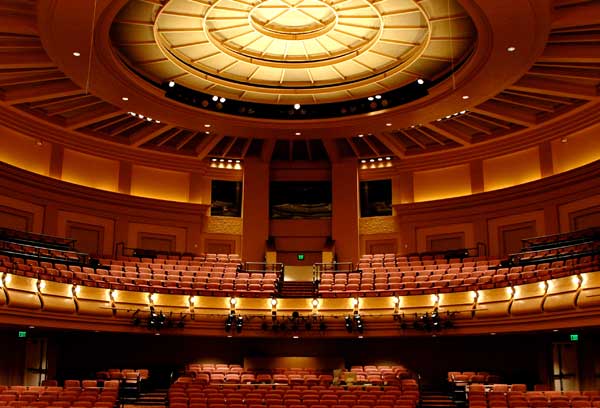 Historically known as Holmberg Hall, the Donald W. Reynolds Performing Arts Center, built in 1918 as part of the University of Oklahoma’s original campus, is one of Oklahoma’s most historic buildings and one of the university’s key educational and community facilities. Originally named simply The Auditorium (1918) and renamed Holmberg Hall (1938), after Fredrick Holmberg who was the Professor of Music and later became the first Dean of the College of Fine Arts. Then in 2002 the building began a multimillion dollar renovation. The original building with the addition of the new dance wing and renovated practice rooms were renamed the Donald W. Reynolds Performing Arts Center (2005), after Donald W. Reynolds.
Historically known as Holmberg Hall, the Donald W. Reynolds Performing Arts Center, built in 1918 as part of the University of Oklahoma’s original campus, is one of Oklahoma’s most historic buildings and one of the university’s key educational and community facilities. Originally named simply The Auditorium (1918) and renamed Holmberg Hall (1938), after Fredrick Holmberg who was the Professor of Music and later became the first Dean of the College of Fine Arts. Then in 2002 the building began a multimillion dollar renovation. The original building with the addition of the new dance wing and renovated practice rooms were renamed the Donald W. Reynolds Performing Arts Center (2005), after Donald W. Reynolds.
The Building’s centerpiece is Oklahoma’s only European-style performance hall, the setting for appearances by famous visitors to Oklahoma, generations of OU student performers, and a wide range of community activities. Sometimes called “Oklahoma’s meeting house,” the building has housed some of the state’s most memorable events.
 When President William Howard Taft, statesman William Jennings Bryan, poet William Butler Yeats, Composer Aaron Copland, and dancer Martha Graham came to Oklahoma, they came to the Reynolds Performing Arts Center (historically known as Holmberg Hall). Former high school students from across the state remember it as the site of music, band, and speech competitions and events.
When President William Howard Taft, statesman William Jennings Bryan, poet William Butler Yeats, Composer Aaron Copland, and dancer Martha Graham came to Oklahoma, they came to the Reynolds Performing Arts Center (historically known as Holmberg Hall). Former high school students from across the state remember it as the site of music, band, and speech competitions and events.
In addition, many of the University of Oklahoma’s landmark events, from OU President James Buchanan’s funeral to football Coach Bud Wilkinson’s national trophy presentation, were held in the facility. OU President David L. Boren chose this stage as the place to announce his acceptance of the OU Presidency and resignation from the United States Senate.
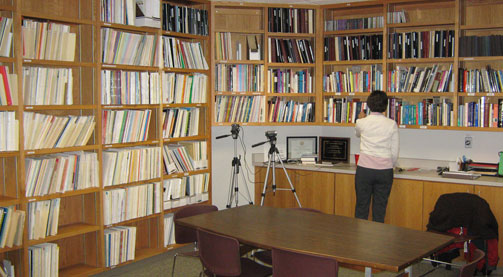 The Ruby Grant Piano Pedagogy Resource Center houses the latest in teaching materials and equipment. It is a center for research in the field by graduate students and visiting scholars on sabbatical leave from colleges and universities throughout the country. The resource center (Catlett Rooms 003 and 004) features a Yamaha keyboard, Macintosh computer, DVD player, video cameras and playback facilities for viewing and listening to tapes, CDs, and DVDs. Numerous current books on piano pedagogy, piano playing, teaching, learning theories, and other topics, musical scores, and periodicals are also housed here. The Ruby Grant Piano Pedagogy Resource Center is a hub for much of the activity in the piano pedagogy programs at the University of Oklahoma.
The Ruby Grant Piano Pedagogy Resource Center houses the latest in teaching materials and equipment. It is a center for research in the field by graduate students and visiting scholars on sabbatical leave from colleges and universities throughout the country. The resource center (Catlett Rooms 003 and 004) features a Yamaha keyboard, Macintosh computer, DVD player, video cameras and playback facilities for viewing and listening to tapes, CDs, and DVDs. Numerous current books on piano pedagogy, piano playing, teaching, learning theories, and other topics, musical scores, and periodicals are also housed here. The Ruby Grant Piano Pedagogy Resource Center is a hub for much of the activity in the piano pedagogy programs at the University of Oklahoma.
Music and Research Materials in the Ruby Grant Piano Pedagogy Resource Center
This center is unique and the heart of student activity in the program. Some of the materials housed in the resource center are listed below.
- Books on music, piano playing, piano teaching, music education
- Professional magazines and journals
- New music issues
- Dissertations and theses
- Average-age piano methods, pre-school piano methods and supplementary materials
- Adult methods
- Classical repertoire series and anthologies of classical music
- Ear training series
- Classical teaching literature by composer
- Educational materials arranged by composer
- Standard solo piano literature
- Standard duet and two-piano repertoire
- Books for the well-equipped piano teacher
- Piano ensemble music for teaching
- Games and teaching aids
- Materials for group piano classes
- Celia Mae Bryant archives
- Juanita Hubbard archives
- DVDs and audio CDs
- Recordings of teaching literature
- Supplementary teaching materials
- Technique books
- Course Offerings in Piano Pedagogy
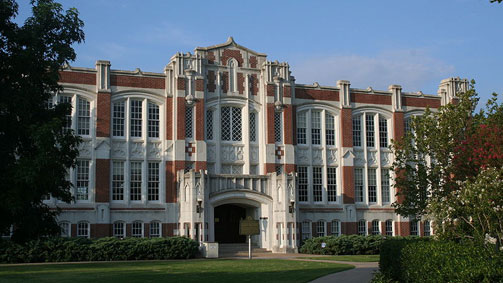 One of the most historic OU arts facilities, it houses the offices and faculty, dance and performance studios of the Max Weitzenhoffer School of Musical Theatre. This building is located on the north end of campus at the corner of Boyd Street and Asp Avenue. It is also one of the most beautiful structures on campus. It is known for its high ceilings, beautiful woodwork and striking architecture.
One of the most historic OU arts facilities, it houses the offices and faculty, dance and performance studios of the Max Weitzenhoffer School of Musical Theatre. This building is located on the north end of campus at the corner of Boyd Street and Asp Avenue. It is also one of the most beautiful structures on campus. It is known for its high ceilings, beautiful woodwork and striking architecture.
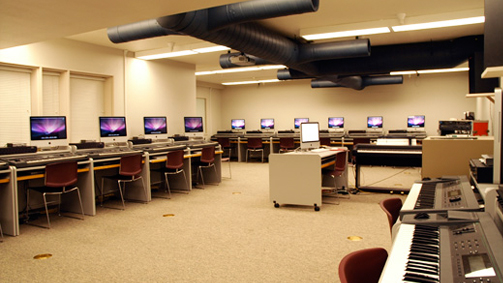 The Music Technology Area teaches in two cutting edge facilities: the Computer Music Studio and the MIDI lab, both located in Catlett Music Center.
The Music Technology Area teaches in two cutting edge facilities: the Computer Music Studio and the MIDI lab, both located in Catlett Music Center.
The MIDI lab with its 20 workstations offers a convenient teaching and studying environment for students who enroll in introductory Music Technology courses.
In the Computer Music Studio, students work with the latest in recording hardware and software which offers students a real-world, hands-on experience in electoacoustic music composition, research, and music recording/production.
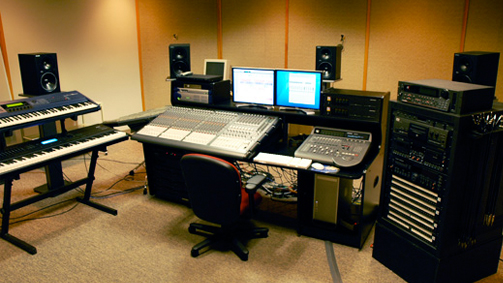 The Computer Music Suite is located on the second floor of the Catlett Music Center and is available to students enrolled in advanced Music Technology courses. Students in these classes have unlimited access to the studio through a swipe card authorization system. The studio consists of a suit of rooms with a control room (Computer Music Studio), two isolation rooms and an amplifier/patch room that allows connections to all major performing spaces in the building. The following is a non-comprehensive list of equipment used in the control room.
The Computer Music Suite is located on the second floor of the Catlett Music Center and is available to students enrolled in advanced Music Technology courses. Students in these classes have unlimited access to the studio through a swipe card authorization system. The studio consists of a suit of rooms with a control room (Computer Music Studio), two isolation rooms and an amplifier/patch room that allows connections to all major performing spaces in the building. The following is a non-comprehensive list of equipment used in the control room.
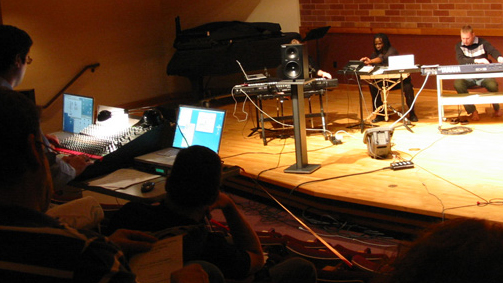 In addition to serving as a teaching and production facility for Music Technology and Music Composition students, the studio has produced several CDs including In Concert! featuring the OU School of Music student ensembles, such as the OU Symphony Orchestra, the Wind Symphony Orchestra, the New Century Ensemble, and the Jazz Ensemble, all recorded, edited and mastered by students enrolled in Recording Techniques. Previous recording projects include Ned Rorem's Song Cycle Ariel with Armand Ambrosini, clarinet; Edward Gates, piano; and Jennie Olson, soprano, available from Kendall/Hunt; Bavarian Horn with Eldon Matlick, horn; Howard Lubin, piano; and Salvatore Champagne, tenor, available on the Mark Masters Series of Mark Custom Recording; as well as on nine companion CDs for the Hal Leonard Corporation.
In addition to serving as a teaching and production facility for Music Technology and Music Composition students, the studio has produced several CDs including In Concert! featuring the OU School of Music student ensembles, such as the OU Symphony Orchestra, the Wind Symphony Orchestra, the New Century Ensemble, and the Jazz Ensemble, all recorded, edited and mastered by students enrolled in Recording Techniques. Previous recording projects include Ned Rorem's Song Cycle Ariel with Armand Ambrosini, clarinet; Edward Gates, piano; and Jennie Olson, soprano, available from Kendall/Hunt; Bavarian Horn with Eldon Matlick, horn; Howard Lubin, piano; and Salvatore Champagne, tenor, available on the Mark Masters Series of Mark Custom Recording; as well as on nine companion CDs for the Hal Leonard Corporation.
 Our MIDI Lab, located on the ground floor of the Catlett Music Center (room 006A), consists of 20 iMac-based student workstations. Although the lab is used for classes on weekday mornings and early afternoons, it is open for student use late afternoons and evenings for four to five hours on average. All first-year introductory Music Technology courses take place in the MIDI lab.
Our MIDI Lab, located on the ground floor of the Catlett Music Center (room 006A), consists of 20 iMac-based student workstations. Although the lab is used for classes on weekday mornings and early afternoons, it is open for student use late afternoons and evenings for four to five hours on average. All first-year introductory Music Technology courses take place in the MIDI lab.
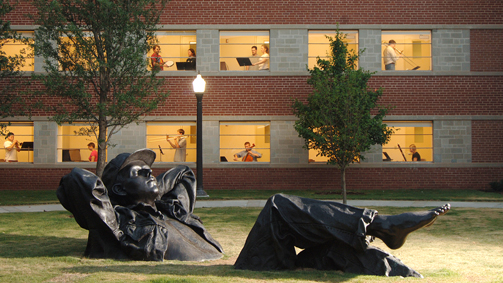 The Reynolds Performing Arts Center includes 50 upgraded music practice rooms, which are filled with students from morning til far into the night. Each room is heavily insulated to reduce noise intrusion.
The Reynolds Performing Arts Center includes 50 upgraded music practice rooms, which are filled with students from morning til far into the night. Each room is heavily insulated to reduce noise intrusion.
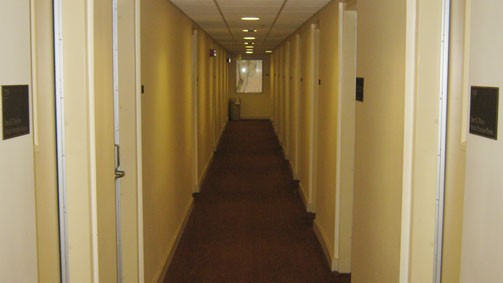
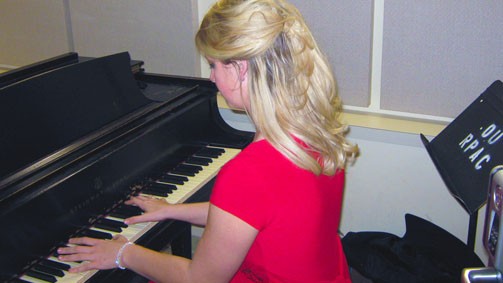
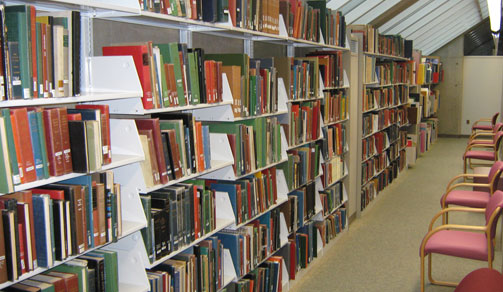 The Grant Fine Arts Library serves as the "neighborhood library" for the Weitzenhoffer Family College of Fine Arts of the University of Oklahoma, supporting their mission to provide “excellence in arts education, scholarship, and creative activities, and the nurture of its students by maintaining a university environment in which the highest professional standards are exemplified through its faculty.” The University remains committed to the arts, President Boren affirming “that no University can be truly great without achieving greatness in the fine arts. We must not…focus solely on the mind and the body, and neglect the spirit. Music and all of the Arts feed the soul. The creative part of us helps us escape the narrow boundaries of our own limited personal experiences.” The library also recognizes its obligation to the local community, the state, other libraries, and scholars in general.
The Grant Fine Arts Library serves as the "neighborhood library" for the Weitzenhoffer Family College of Fine Arts of the University of Oklahoma, supporting their mission to provide “excellence in arts education, scholarship, and creative activities, and the nurture of its students by maintaining a university environment in which the highest professional standards are exemplified through its faculty.” The University remains committed to the arts, President Boren affirming “that no University can be truly great without achieving greatness in the fine arts. We must not…focus solely on the mind and the body, and neglect the spirit. Music and all of the Arts feed the soul. The creative part of us helps us escape the narrow boundaries of our own limited personal experiences.” The library also recognizes its obligation to the local community, the state, other libraries, and scholars in general.
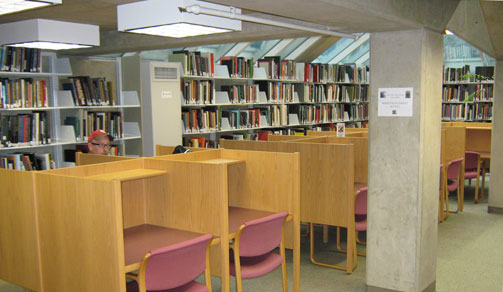 Created by the merger of three smaller departmental libraries in 1986, the Fine Arts Library is located in room 020 on the lower level of Catlett Music Center on the corner of Elm and Boyd streets. The Fine Arts Library holds approximately 140,000 books, scores, and bound periodicals. Sound and video recordings are collected by the Media Resource Center, a separate entity, located within the Fine Arts Library, and administered by the College of Fine Arts.
Created by the merger of three smaller departmental libraries in 1986, the Fine Arts Library is located in room 020 on the lower level of Catlett Music Center on the corner of Elm and Boyd streets. The Fine Arts Library holds approximately 140,000 books, scores, and bound periodicals. Sound and video recordings are collected by the Media Resource Center, a separate entity, located within the Fine Arts Library, and administered by the College of Fine Arts.
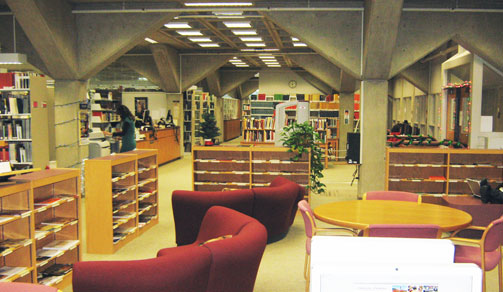 The collection has been carefully built to support the needs of the College, which offers bachelors and masters degrees from each School as well as doctorates in music performance or conducting. The Ph.D. is offered in Music Education and in Art of the American West/Native American Art. The Helen Carpenter endowment fund supports the acquisition of important scholarly works such as catalogue raisonnés and the collected works of composers from the Middle Ages to the present. Electronic resources available include: Art Index, Art Index Retrospective, Bibliography of the History of Art, ARTstor, JSTOR, International Bibliography of Theatre and Dance, RILM, RIPM, Dance in Video, Opera in Video, and numerous reference works from Oxford University Press. Special collections include 8,000 pieces of sheet music from the 1890s to the 1960s and a collection of harp music donated by Lawrence Odom, formerly principal harpist at the Kennedy Center Opera House, Washington, D.C.
The collection has been carefully built to support the needs of the College, which offers bachelors and masters degrees from each School as well as doctorates in music performance or conducting. The Ph.D. is offered in Music Education and in Art of the American West/Native American Art. The Helen Carpenter endowment fund supports the acquisition of important scholarly works such as catalogue raisonnés and the collected works of composers from the Middle Ages to the present. Electronic resources available include: Art Index, Art Index Retrospective, Bibliography of the History of Art, ARTstor, JSTOR, International Bibliography of Theatre and Dance, RILM, RIPM, Dance in Video, Opera in Video, and numerous reference works from Oxford University Press. Special collections include 8,000 pieces of sheet music from the 1890s to the 1960s and a collection of harp music donated by Lawrence Odom, formerly principal harpist at the Kennedy Center Opera House, Washington, D.C.
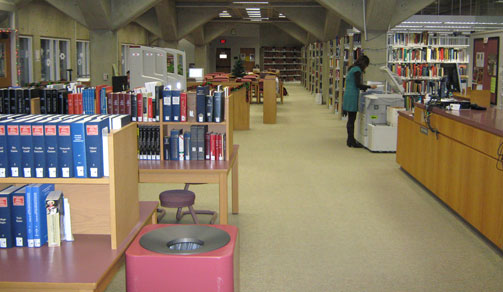 The Fine Arts Library circulates over 33,000 items each year and strives to constantly reach a greater number of students, staff, and faculty. Outreach activities include numerous tours and instruction sessions for a wide variety of courses, both within the College of Fine Arts and across the university, a newsletter, and an active presence on Facebook. A Librarian on Location program at the School of Art & Art History continue to expand our services beyond the walls of the library as we continue to evolve to meet the ever changing needs of the college, the university, and the community.
The Fine Arts Library circulates over 33,000 items each year and strives to constantly reach a greater number of students, staff, and faculty. Outreach activities include numerous tours and instruction sessions for a wide variety of courses, both within the College of Fine Arts and across the university, a newsletter, and an active presence on Facebook. A Librarian on Location program at the School of Art & Art History continue to expand our services beyond the walls of the library as we continue to evolve to meet the ever changing needs of the college, the university, and the community.
 The Media Resource Center (MRC), a service of the Weitzenhoffer Family College of Fine Arts, is a working library of time-based (non-book) materials: CDs, videos, digital audio tapes (DATs) and regular cassette tapes, digital video discs (DVDs) and long-playing records (LPs). These are available to anyone who wishes to use them in the Ruby Grant Fine Arts Library. Faculty, staff and graduate students (but not undergraduates) may also borrow items for short periods.
The Media Resource Center (MRC), a service of the Weitzenhoffer Family College of Fine Arts, is a working library of time-based (non-book) materials: CDs, videos, digital audio tapes (DATs) and regular cassette tapes, digital video discs (DVDs) and long-playing records (LPs). These are available to anyone who wishes to use them in the Ruby Grant Fine Arts Library. Faculty, staff and graduate students (but not undergraduates) may also borrow items for short periods.
The MRC is the enclosed unit within the Fine Arts Library on the lower level of the Catlett Music Center, located at the corner of Boyd and Elm on the Norman Campus of OU. Once through the Fine Arts Library doors, follow the signs to the MRC (turning right, past the main library counter).
During the semester the MRC is normally open at the same time as the Fine Arts Library. At other times there are differences – see below for details:
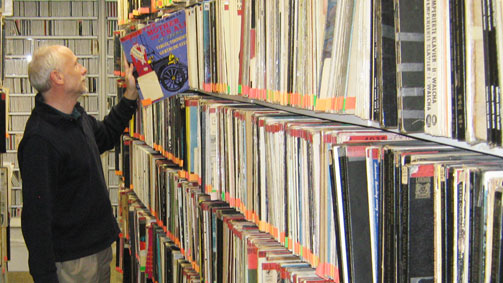 During the Semester:
During the Semester:
Monday - Thursday: 8am - 9pm
Friday: 8am - 5pm
Saturday: 11am - 5pm
Sunday: 2pm - 9pm
During Intersessions:
Monday - Friday: 10am - 2pm
Summer hours:
Monday - Friday: 10am - 4pm
If you are traveling any distance to use the MRC, it is best to call (405) 325-6492 first to make sure the center is open.
















